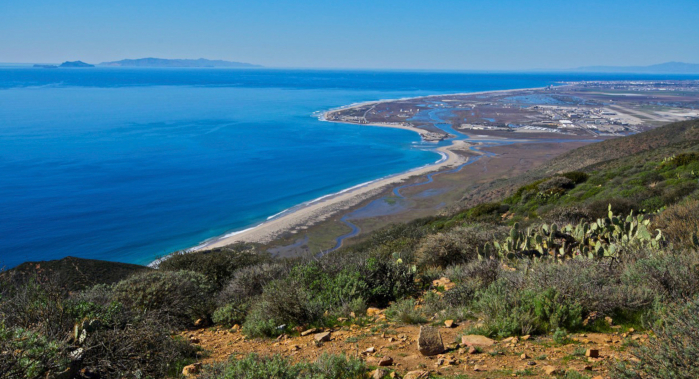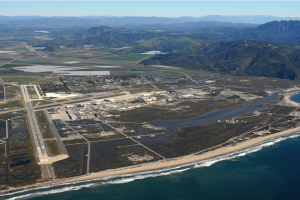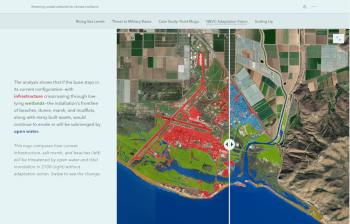How can we protect natural resource and coastal military assets from sea level rise?

Among the Department of Defense’s California installations is Naval Base Ventura County (NBVC) Point Mugu, a premier testing and training facility. Point Mugu occupies over six miles of coastline about an hour’s drive northwest from Los Angeles. Photo: © Kevin Arnold
By Alyssa Mann, Walter Heady, and Charlotte Stanley
Resouces mentioned below can be found here: full report, StoryMap that accompanies this report, technical report and 2-page summary.
The Department of Defense (DoD) has long viewed environmental conservation across its lands as integral to its mission. Military training and testing require undeveloped and often natural land to simulate wartime conditions. In California alone, DoD controls 200,000 acres of coastal land. DoD also determined that climate change is a threat to national security, and are recognizing the important role for nature in building resilience. In 2021, The Nature Conservancy (TNC) collaborated with the U.S. Army Corps’ Engineering with Nature program to publish a collection of case studies of nature-based solutions for resilience on U.S. military installations, including featuring our collaboration with U.S. Navy in California.
TNC and the United States Navy partnered together to prepare for the impacts of climate change on Naval Base Ventura County (NBVC), Point Mugu in California. NBVC is a critical and strategic asset of the U.S. Navy. It is also home to Mugu Lagoon, the largest and most intact saltmarsh in Southern California, supporting high biodiversity including many imperiled species. Protecting and enhancing Mugu Lagoon’s coastal habitats is critical to NBVC resilience, absorbing flood waters and buffering the base from sea level rise and coastal flooding and erosion. Without action, this amazing natural resource and military assets are both vulnerable to loss.
If no action is taken, a large portion of NBVC Point Mugu’s built assets and wetlands would convert to open water by 2060 due to sea level rise and associated erosion and flooding. The Coastal Adaptation Vision for NBVC would create over 700 acres of space for restoration and natural infrastructure, significantly reducing vulnerability to current and future hazards.

The U.S. Navy-TNC collaboration launched in 2016, marking the first time the Department of Defense (DoD) partnered with an NGO to protect a military installation from sea level rise and climate change. Goals of the partnership are to evaluate vulnerabilities to sea level rise and coastal hazards at Point Mugu and develop a vision for adaptation to achieve long-term resilience and support the military mission. Using a strong foundation of science, TNC, the Navy, and partners identified strategies and pathways to improve the resilience and function of both built infrastructure and natural ecosystems. Learn more therough the resources below.
 The StoryMap that accompanies this report describes the threat of sea level rise, DoD's focus on nature-based solutions for resilience, the case study at NBVC Point Mugu, and how this work can be scaled across the country and around the world.
The StoryMap that accompanies this report describes the threat of sea level rise, DoD's focus on nature-based solutions for resilience, the case study at NBVC Point Mugu, and how this work can be scaled across the country and around the world.
In addition, the full report, technical report and 2-page summary are available below.
For more information, contact Alyssa Mann.
Environmental Science Associates (ESA) for The Nature Conservancy and Naval Base Ventura County
Charlotte Stanley, Alyssa Mann, Walter Heady
The United States operates thousands of military installations in the U.S. and worldwide, worth about $1.2 trillion. These facilities are where personnel train and test weaponry, with…Walter Heady, Alyssa Mann, Stacey Solie, Bob Battalio, James Jackson, Kendall Lousen, and Bob Barnes
The U.S. Congress and the Department of Defense (DoD) have determined that climate change is a threat to national security and have required military installations to develop plans to improve the…Alyssa Mann, Walter Heady, Charlotte Stanley
TNC and the United States Navy partnered together to prepare for the impacts of climate change on Naval Base Ventura County (NBVC), Point Mugu in California. NBVC is a critical and strategic asset of…